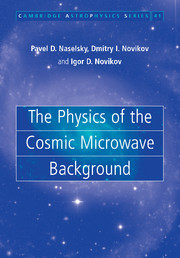Book contents
- Frontmatter
- Contents
- Preface to the Russian edition
- Preface to the English edition
- 1 Observational foundations of modern cosmology
- 2 Kinetics of electromagnetic radiation in a uniform Universe
- 3 The ionization history of the Universe
- 4 Primordial CMB and small perturbations of uniform cosmological model
- 5 Primary anisotropy of the cosmic microwave background
- 6 Primordial polarization of the cosmic microwave background
- 7 Statistical properties of random fields of anisotropy and polarization in the CMB
- 8 The Wilkinson Microwave Anisotropy Probe (WMAP)
- 9 The ‘Planckian era’ in the study of anisotropy and polarization of the CMB
- 10 Conclusion
- References
- Index
8 - The Wilkinson Microwave Anisotropy Probe (WMAP)
Published online by Cambridge University Press: 18 August 2009
- Frontmatter
- Contents
- Preface to the Russian edition
- Preface to the English edition
- 1 Observational foundations of modern cosmology
- 2 Kinetics of electromagnetic radiation in a uniform Universe
- 3 The ionization history of the Universe
- 4 Primordial CMB and small perturbations of uniform cosmological model
- 5 Primary anisotropy of the cosmic microwave background
- 6 Primordial polarization of the cosmic microwave background
- 7 Statistical properties of random fields of anisotropy and polarization in the CMB
- 8 The Wilkinson Microwave Anisotropy Probe (WMAP)
- 9 The ‘Planckian era’ in the study of anisotropy and polarization of the CMB
- 10 Conclusion
- References
- Index
Summary
Mission and instrument
The successful launch of the WMAP (Wilkinson Microwave Anisotropy Probe) mission in June 2001 signalled a new epoch in the investigation of the cosmic microwave background. This experiment differs from all previous satellite-, balloon- and ground-based experiments by unprecedented precision and sensitivity.
The WMAP mission has been designed to determine the power spectrum of the CMB anisotropy and polarization and subsequently to estimate such cosmological parameters as the Hubble constant H0, the baryonic fraction of dark matter Ωb, the geometry ΩK of the Universe, etc. These observations provide an independent check on the COBE results, determine whether the anisotropy obeys Gaussian statistics, and verify whether the predicted temperature–polarization correlation is present.
The high-level features of the WMAP mission can be briefly described as follows. The mission is designed to produce an almost full (>95% of the entire sky) map of the CMB temperature fluctuations with ≃0.2° angular resolution, accuracy on all angular scales >0.2°, accurate calibration (<0.5% uncertainty), an overall sensitivity level of ΔTrms < 20 μK per pixel (for 393 216 sky pixels, 3.2 × 10−5 ster per pixel) and systematic errors limited to <5% of the random variance on all angular scales.
We have taken information from Page (2000) to describe the instrument. The instrument measures temperature differences from two regions of the sky separated by ∼140°. It is composed of ten symmetric, passively cooled, dual-polarization differential microwave receivers.
- Type
- Chapter
- Information
- The Physics of the Cosmic Microwave Background , pp. 216 - 224Publisher: Cambridge University PressPrint publication year: 2006
- 3
- Cited by



